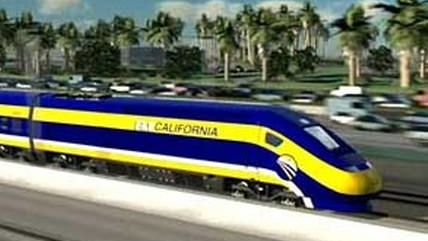Calif. Bullet Train Proponents Tout Moderately Skeptical GAO Report
If the project fails, maybe Rail Authority leaders can find work picking cherries


In response to critics' worries that California's bullet train plan relies on projections of costs, revenues, and ridership that are far too optimistic, proponents are seeking refuge under a new Government Accountability Office report that – er – worries that the plan's costs, revenues and ridership projections are too optimistic.
The California High Speed Rail Authority (CHSRA) is all smiles and sunbeams about the report though in their press release:
"The GAO's audit report is extremely clear that the Authority's processes and methodologies in estimating its costs, revenue and ridership are sound," said Dan Richard, Chair of the Authority's Board of Directors. "The Authority appreciates the GAO's input and is already taking steps to incorporate those suggestions."
No. That's not quite right. Note the weasel words of "processes and methodologies." In actuality, the full GAO report (pdf) determined that a significant chunk of the estimations are really half-complete and takes great pains to warn that because the United States has never embarked in a high-speed rail project of this magnitude before, the Authority really, really, really needs to be careful about the quality of its projections. The GAO also repeatedly expresses concerns about how the rail project could possibly get private investment when it can't yet secure construction funding beyond the earliest stages:
Private-sector investment in the California high-speed rail project, if any, will ultimately be determined by the profitability of the system—that is, the extent to which operating revenues exceed operating costs. The Authority currently estimates an operating profit in the first and all subsequent years of operation. However, this estimate is only as reliable as the underlying operating cost and revenue forecasts. As discussed earlier, the Authority's current ridership and revenue forecasts are reasonable for planning purposes, however, further refinements will be required as the project continues to evolve. The Authority's current operating cost estimates will also need to be improved in the future. Accordingly, both cost and ridership forecasts will change before the initial operating segment is completed in 2022, making the future value of potential private funding uncertain at this time. [Emphasis added]
The Reason Foundation (the non-profit that publishes Reason.com and Reason magazine) has updated its criticism of the projections today and estimates that, in reality, the rail line will need significant annual subsidies from $124 to $373 million to operate, which puts the project at odds with the state ballot initiative that authorizes its construction. And due to changes in the rail project's plans that will see it sharing train tracks in San Francisco and Los Angeles, the Authority is misleading the public, and the GAO, on how long the trips will take:
In 2008, voters were promised a bullet train trip from Los Angeles to San Francisco in two hours and forty minutes. However, the Reason study finds the system's fastest non-stop trip is likely to take nearly four hours — 3:50, and most trips on the system would take 4:40 or longer.
Sharing tracks with freight trains in some locations, as the California High-Speed Rail Authority has opted to do in order to lower construction costs, would also reduce speeds to 100 to 150 miles per hour in those places.
The Rail Authority claims the train would make up for using blended tracks by going 220 miles per hour in other stretches. However, that simply isn't realistic—no train in the world achieves those speeds at this time. The fastest train, France's TGV, travels at 199 miles per hour.
If the California rail system fails to deliver on its promised trip times, other problems would mount. Longer travel times would make the train less appealing to people who could opt to fly or drive. Lower ridership numbers would also prompt the need for higher ticket prices. In 2008, voters were promised fares of "about $50 a person." Tickets are now expected to cost $81, which would further reduce ridership.
You can read the Reason Foundation's new report here (pdf). The Reason Foundation further deflates the Rail Authority's claims that the GAO report supports the bullet train's construction here.

Show Comments (41)